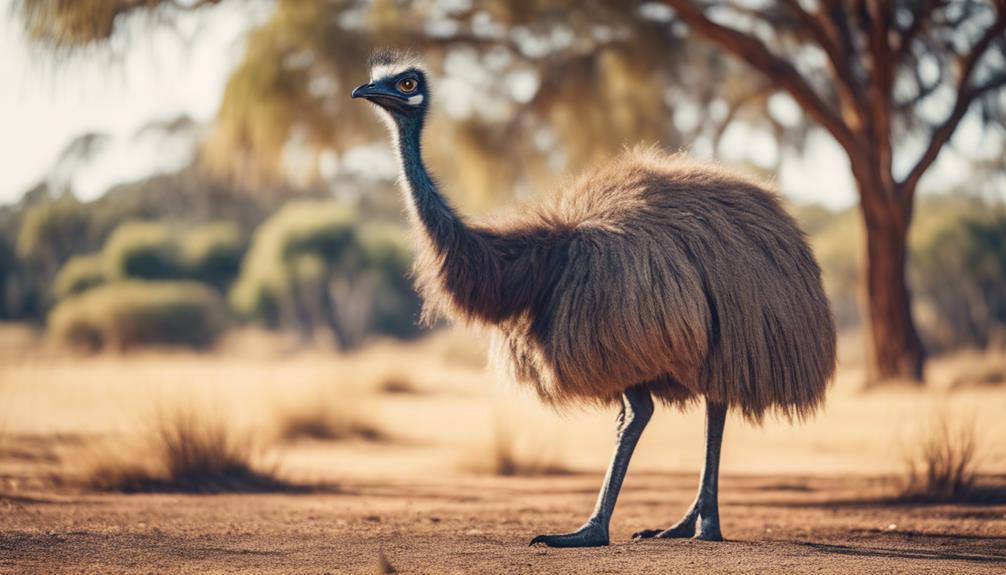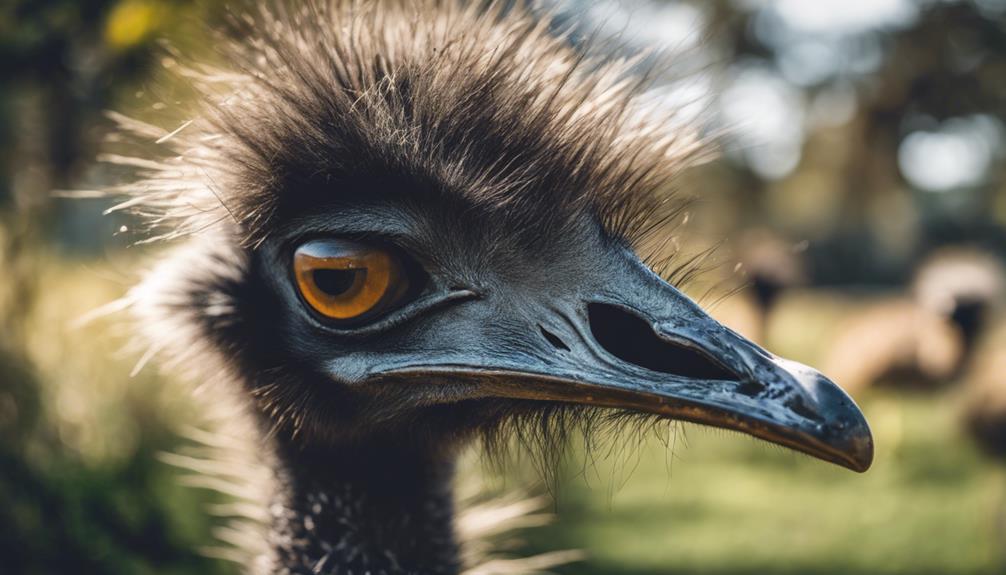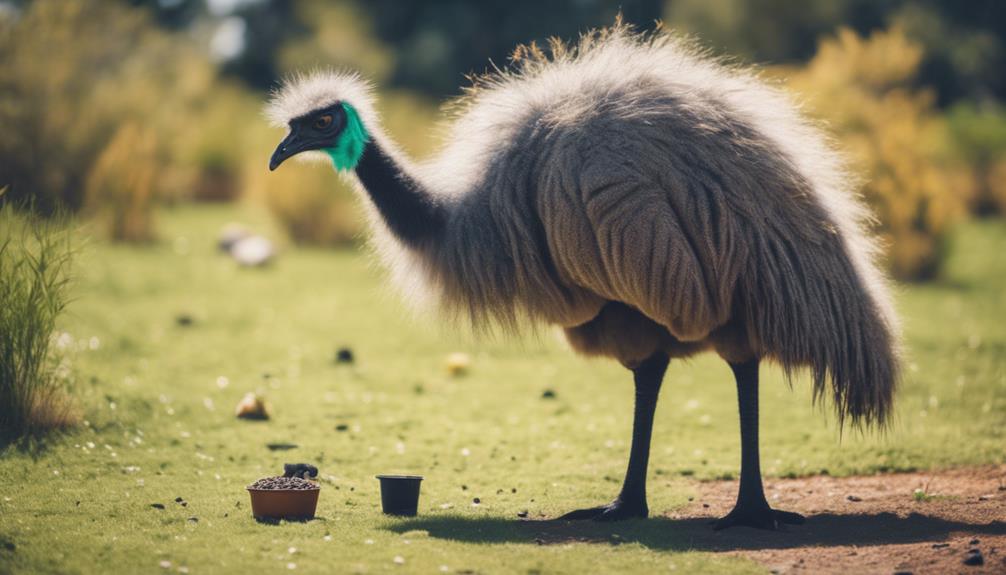
In the vast expanse between the untamed wilderness and the confined boundaries of captivity, the world of emus unfolds in intriguing ways. Amidst the contrasting environments lie a myriad of factors that shape the lives of these enigmatic creatures. From their natural behaviors to the challenges posed by human interference, the discussion on emus in the wild versus captivity delves into a realm where adaptation and conservation efforts intertwine. Explore the nuances of emu existence as we unravel the complexities that define their journey through different landscapes.
Key Takeaways
- Emus in the wild exhibit natural behaviors like foraging, hierarchy establishment, and courtship displays.
- Captive emus display altered behaviors due to reduced stress from predators and increased human interaction.
- Emu enclosure design in captivity should consider space, foraging areas, shelters, water sources, and temperature regulation.
- Breeding success in captivity relies on nutrition, environmental enrichment, and compatibility of breeding pairs.
- Conservation efforts aim to protect habitats, monitor populations, engage communities, and preserve natural environments.
Emu Habitat Differences

Emus in the wild exhibit distinct habitat preferences compared to those in captivity, influencing their behavior and overall well-being. In their natural environment, wild emus favor vast open spaces with varied terrain, including grasslands, savannas, and forests with access to water sources. These habitats provide ample opportunities for foraging, social interaction, and escape from potential threats. The freedom to roam over large distances allows wild emus to engage in their natural migratory patterns and exercise their instinctual behaviors effectively.
Conversely, emus in captivity often experience restricted movement and limited access to diverse landscapes, which can lead to behavioral issues such as pacing, aggression, or even health problems like obesity. The artificial environments provided in captivity, although designed with care, may not fully meet the complex habitat requirements essential for the psychological and physical well-being of these majestic birds. Understanding and replicating the intricate balance of elements found in the wild habitats of emus is crucial for enhancing their quality of life in captivity.
Feeding Behavior Contrasts
In the context of feeding behavior, the diet composition of emus in the wild differs significantly from those in captivity. Emus in the wild exhibit a more diverse and natural feeding behavior compared to their captive counterparts. Here are three key differences to consider:
- Foraging Patterns: Wild emus spend a substantial amount of time foraging for a variety of vegetation, insects, and small vertebrates. This constant search for food not only fulfills their nutritional needs but also engages their natural instincts for survival.
- Opportunistic Feeding: In the wild, emus opportunistically feed on a wide range of food sources based on seasonal availability and abundance. This adaptive feeding behavior allows them to thrive in diverse environments and ensures their dietary requirements are met.
- Nutritional Intake: The varied diet of wild emus provides a more balanced nutritional intake, rich in essential nutrients and vitamins crucial for their overall health and well-being. This contrasts with captive emus, whose diet may be more restricted and less varied, potentially leading to nutritional deficiencies.
Social Interactions Variances

Social interactions among emus in different environments exhibit noticeable variances that reflect their adaptation to their surroundings. In the wild, emus display a complex social structure where dominant individuals establish hierarchies through displays of aggression and vocalizations. These interactions are crucial for maintaining order within the group and ensuring efficient foraging and protection against predators. Emus in captivity, on the other hand, often exhibit altered social behaviors due to the artificial setting. They may display reduced aggression levels and altered dominance hierarchies, as the constraints of captivity can impact their natural social dynamics.
Observations of emus in the wild reveal intricate communication patterns, such as vocalizations and body language, that facilitate social cohesion and cooperation. In captivity, these communication skills may be less pronounced, leading to potential challenges in group dynamics. Understanding these social interaction variances between wild and captive emus is essential for ensuring their well-being and successful breeding programs in captivity. By studying and adapting to these differences, we can create environments that support the social needs of emus, whether in the wild or in captivity.
Reproduction Varied Responses
Within different settings, the responses of emus to reproduction vary significantly, reflecting adaptations to their specific environments. In the wild, emus exhibit intricate behaviors that enhance their reproductive success:
- Courtship Rituals: Emus in the wild engage in elaborate courtship displays involving dancing, vocalizations, and plumage flaunting. These rituals demonstrate dominance and attract potential mates, ensuring the strongest genes are passed on.
- Nesting Habits: Wild emus meticulously select nesting sites, often in hidden locations to protect their eggs from predators. The choice of nesting material and construction reflect the female's ability to provide a safe environment for incubation.
- Parental Care: Wild emus demonstrate a remarkable level of parental care, with both male and female emus taking turns incubating the eggs and raising the chicks. This shared responsibility increases the chances of survival for the offspring by providing them with essential protection and guidance.
Predation Risks Comparison

Predation risks significantly differ between wild and captive emus, impacting their survival strategies and behavior adaptations. In the wild, emus face a range of natural predators such as dingoes, foxes, and eagles. These predators have honed their hunting skills over generations, making wild emus constantly vigilant and adept at detecting potential threats. As a response, wild emus have developed strong social structures and communication methods to alert each other of danger swiftly.
On the other hand, emus in captivity are shielded from the direct threat of predators. This security leads to a lack of necessity for constant vigilance, resulting in captive emus exhibiting behaviors that are less focused on evasion and defense. Consequently, captive emus may display reduced stress levels compared to their wild counterparts but may also lack the same level of alertness and quick reflexes necessary for survival in the wild.
Understanding these differences in predation risks is crucial for designing effective conservation and management strategies for both wild and captive emu populations.
Human Interaction Impacts
Human interactions significantly influence the behavior and well-being of emus in both wild and captive environments. In the wild, interactions with humans can lead to changes in emu behavior and physiology.
Here are three impactful ways human interactions affect emus:
- Stress Response: Human presence, especially in the form of frequent visits or disturbances, can elevate stress levels in emus. This heightened stress can impact their overall health and well-being, leading to altered behavior patterns and reduced reproductive success.
- Feeding Habits: Feeding emus in the wild can disrupt their natural foraging behaviors. Dependence on human-provided food sources can lead to malnutrition and health issues, affecting their ability to thrive in their natural habitat.
- Social Dynamics: Interactions with humans can alter emus' social structures. In captivity, human interactions may replace natural social hierarchies, impacting breeding success and overall social behaviors among emus.
It's crucial to consider the implications of human interactions on emus to ensure their welfare in both wild and captive settings.
Health and Well-being Variances

Emus exhibit distinct variations in health and well-being between their wild and captive environments, reflecting the impact of differing living conditions on their overall physiological state. In the wild, emus experience a more diverse diet, consisting of various plants, insects, and small vertebrates, leading to better overall health. Their natural habitat provides ample space for exercise, promoting cardiovascular health and muscle development. Additionally, wild emus have lower stress levels, as they aren't confined or subjected to the disturbances often present in captive settings.
On the other hand, emus in captivity may face health challenges due to limited space for movement and lack of diverse dietary options. These factors can lead to obesity, muscle atrophy, and other related health issues. Furthermore, captive emus may exhibit higher stress levels resulting from confinement and human interaction, impacting their overall well-being.
Understanding these health and well-being variances between wild and captive emus is crucial for ensuring the proper care and management of these fascinating birds in different environments.
Behavioral Adaptations in Captivity
In the controlled environment of captivity, emus often exhibit behavioral adaptations that differ significantly from their wild counterparts. These adaptations are crucial for survival and comfort in the artificial setting, shaping the emus' behavior in distinctive ways:
- Increased Sociability: Emus in captivity tend to show higher levels of social interaction compared to their wild counterparts. The limited space and constant presence of other emus lead to the development of intricate social hierarchies within captive groups.
- Altered Foraging Behavior: Captive emus adapt their foraging strategies to suit the provided food sources. They may display more exploratory behavior towards novel food items and show a preference for processed feeds over natural forage.
- Reduced Territorial Aggression: The confined spaces in captivity often result in decreased territorial aggression among emus. This shift in behavior reflects the adjustment to a shared living environment where resources aren't as scarce as in the wild.
Emu Enclosure Design Factors

When considering the design of emu enclosures, the spatial layout plays a critical role in facilitating natural behaviors and optimizing welfare outcomes for the birds. Emus require ample space to move around freely, as they're large, flightless birds with a strong instinct for roaming. Enclosure dimensions must be carefully planned to accommodate the birds' need for exercise and social interaction while ensuring safety and security.
The layout of the enclosure should include areas for foraging, resting, and dust bathing. Providing different substrates such as grassy patches, sand, and pebbles can mimic their natural habitat and encourage a range of natural behaviors. Additionally, incorporating shelters or structures that offer shade and protection from the elements is essential for the birds' well-being.
Water sources should be easily accessible, and the enclosure should be designed to allow for proper drainage to prevent waterlogging. Emus are sensitive to temperature changes, so the enclosure should also have areas with varying degrees of sunlight exposure to allow the birds to regulate their body temperature effectively. By carefully considering these design factors, emu enclosures can effectively support the birds' physical and psychological needs in captivity.
Breeding Success Rates Comparison
Considering the design of emu enclosures and their impact on the birds' welfare, it's pertinent to analyze the breeding success rates in both wild and captive settings for a comprehensive understanding of their reproductive outcomes.
In captivity, breeding success rates can be significantly influenced by various factors such as:
- Nutritional Support: Adequate nutrition plays a vital role in enhancing breeding success rates among emus in captivity. Ensuring a balanced diet rich in essential nutrients can positively impact reproductive outcomes.
- Environmental Enrichment: Providing suitable environmental enrichment within captive settings can stimulate natural breeding behaviors, leading to increased breeding success rates. Enrichment activities that mimic the birds' natural habitat can be beneficial.
- Breeding Pair Compatibility: Pairing emus based on compatibility can have a substantial effect on breeding success rates. Ensuring that breeding pairs have harmonious relationships can enhance reproductive success in captive environments.
Analyzing these factors can offer valuable insights into improving breeding success rates among emus in captivity, ultimately contributing to the conservation efforts of this magnificent species.
Emu Diet in Captivity

Amidst the controlled environment of captivity, emus' dietary requirements play a crucial role in maintaining their health and reproductive success. In captivity, emus are typically fed a diet that mimics their natural intake in the wild. This diet consists mainly of high-fiber pellets, grains, fruits, and vegetables. These pellets are specially formulated to provide the necessary nutrients that emus require for optimal growth and reproduction.
It is essential to monitor the emus' food intake carefully to ensure they're receiving adequate nutrition. Emus are herbivores, and their diet should be rich in fiber, low in fat, and include a variety of vitamins and minerals. Feeding schedules must be consistent to prevent digestive issues and maintain their overall well-being.
Additionally, access to fresh water is paramount for emus in captivity. Proper hydration is vital for their health and plays a significant role in their reproductive success. By adhering to a well-balanced diet and ensuring access to clean water, caretakers can support the health and vitality of emus in captivity.
Emu Conservation Efforts
Emu conservation efforts focus on preserving the natural habitats and population numbers of these unique flightless birds. To ensure the survival of emus in the wild, conservationists employ various strategies:
- Habitat Protection: By safeguarding the diverse ecosystems where emus thrive, conservationists aim to maintain the intricate balance crucial for the birds' survival. Protecting their habitats not only benefits emus but also contributes to the overall health of the ecosystem.
- Population Monitoring: Through rigorous population monitoring techniques, researchers can track the fluctuations in emu numbers. This data is vital for identifying trends, potential threats, and implementing targeted conservation measures to bolster dwindling populations.
- Community Engagement: Encouraging local communities to participate in conservation efforts fosters a sense of responsibility and stewardship towards emus. By involving communities in habitat restoration projects and educational programs, conservationists can amplify their impact and create a network of dedicated individuals working towards a common goal.
Frequently Asked Questions
Do Emus in Captivity Exhibit Different Migration Patterns Than Those in the Wild?
In captivity, emus do not exhibit migration patterns like those in the wild. Factors such as limited space and resources influence their behavior. Observations suggest that captive emus may show altered movement patterns compared to their wild counterparts.
How Do Emus in the Wild and in Captivity Differ in Terms of Territorial Behavior?
Do emus establish territories differently in the wild versus captivity? In the wild, emus fiercely defend large areas for mating and nesting. In captivity, limited space can lead to less territorial aggression and altered behaviors. Understanding these differences is crucial.
Are There Differences in the Vocalizations of Emus Living in the Wild Versus in Captivity?
In the wild, emus exhibit diverse vocalizations, conveying territorial, social, and mating messages. In captivity, limited space and social dynamics can alter vocal patterns. Understanding these differences can provide insights into emu communication behaviors.
Do Emus in Captivity Display Different Courtship Rituals Compared to Their Wild Counterparts?
In captivity, emus may exhibit altered courtship behaviors due to restricted environments and social dynamics. These changes can include differences in vocalizations, displays, and interactions compared to their counterparts in the wild, impacting breeding success and social structures.
Are There Variations in the Stress Levels Experienced by Emus in the Wild Versus Those in Captivity?
In the wild, emus face natural stressors such as predators and food scarcity, whereas captivity can introduce stress from confinement and social dynamics. Understanding these variations in stress levels is crucial for ensuring emus' well-being.
Conclusion
In conclusion, the differences between emus in the wild and in captivity highlight the importance of understanding their natural behaviors and needs.
While some may argue that captivity provides protection from predators, it's essential to consider the potential impacts on their social interactions and overall well-being.
By implementing appropriate enclosure design and diet, we can support the health and welfare of captive emus while also contributing to conservation efforts for this unique species.




